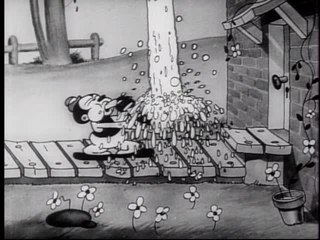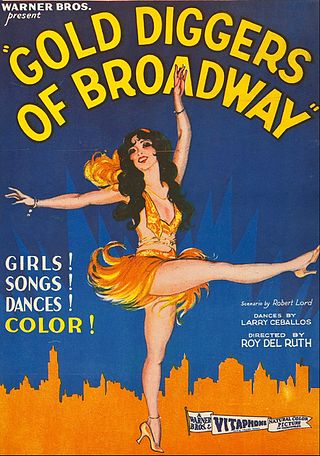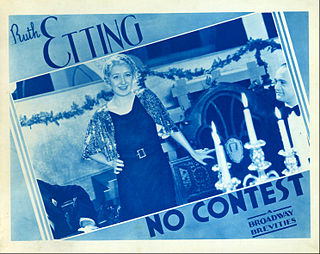Related Research Articles

Vitaphone was a sound film system used for feature films and nearly 1,000 short subjects made by Warner Bros. and its sister studio First National from 1926 to 1931. Vitaphone is the last major analog sound-on-disc system and the only one that was widely used and commercially successful. The soundtrack is not printed on the film, but issued separately on phonograph records. The discs, recorded at 33+1⁄3 rpm and typically 16 inches (41 cm) in diameter, are played on a turntable physically coupled to the projector motor while the film is projected. Its frequency response is 4300 Hz. Many early talkies, such as The Jazz Singer (1927), used the Vitaphone system. The name "Vitaphone" derived from the Latin and Greek words, respectively, for "living" and "sound".

Sinkin' in the Bathtub is the first Warner Bros. theatrical cartoon short as well as the first of the Looney Tunes series. The short was released on April 19, 1930, at the Warner Bros. Theater in Hollywood. The cartoon features Bosko, and the title is a pun on the 1929 song Singin' in the Bathtub. The film was erroneously copyrighted under the same title as the 1929 song. It is now in the public domain in the United States as the copyright was not renewed.

Henry William George Lupino professionally Lupino Lane, was an English actor and theatre manager, and a member of the famous Lupino family, which eventually included his niece, the screenwriter/director/actress Ida Lupino. Lane started out as a child performer, known as 'Little Nipper', and went on to appear in a wide range of theatrical, music hall and film performances. Increasingly celebrated for his silent comedy short subjects, he is best known in the United Kingdom for playing Bill Snibson in the play and film Me and My Girl, which popularized the song and dance routine "The Lambeth Walk".

Gold Diggers of Broadway is a 1929 American pre-Code musical comedy film directed by Roy Del Ruth and starring Winnie Lightner and Nick Lucas. Distributed by Warner Bros., the film is the second all-talking, all-Technicolor feature-length film.

The Show of Shows is a 1929 American pre-Code musical revue film directed by John G. Adolfi and distributed by Warner Bros. The all-talking Vitaphone production cost almost $800,000 and was shot almost entirely in Technicolor.

Sally is a 1929 American Pre-Code film. It is the fourth all-sound, all-color feature film made, and it was photographed in the Technicolor process. It was the sixth feature film to contain color that had been released by Warner Bros.; the first five were The Desert Song (1929), On with the Show! (1929), Gold Diggers of Broadway (1929), Paris (1929) and The Show of Shows (1929).. Although exhibited in a few theaters in December 1929, Sally entered general release on January 12, 1930.
Meglin Kiddies was an American troupe of acting, music and dance performers, consisting of children up to the age of 16. It was also known as The Meglin Professional Children's School, The Meglin Dance Studio, Meglin's Dance School, and Meglin's Wondrous Hollywood Kiddies.

The Desert Song is a 1929 American pre-Code operetta film directed by Roy Del Ruth and starring John Boles, Carlotta King, Louise Fazenda, and Myrna Loy. It was photographed partly in two-color Technicolor, the first film released by Warner Bros. to include footage in color. The film included a 10-minute intermission during which music was played.

Showgirl in Hollywood is a 1930 American pre-Code all-talking musical film with Technicolor sequences, produced and distributed by First National Pictures, a subsidiary of Warner Bros. The film stars Alice White, Jack Mulhall and Blanche Sweet. It was adapted from the 1929 novel Hollywood Girl by J.P. McEvoy.

Paris is a 1929 American pre-Code musical comedy film, featuring Irène Bordoni. It was filmed with Technicolor sequences: four of the film's ten reels were originally photographed in Technicolor.

General Crack is a 1929 American pre-Code sound all-talking historical costume melodrama with Technicolor sequences which was directed by Alan Crosland and produced and distributed by Warner Bros. It was filmed and premiered in 1929, and released early in 1930. It stars John Barrymore in his first full-length talking feature. The film would prove to be Crosland and Barrymore's last historical epic together. It was based on the 1928 novel General Crack by the British writer Marjorie Bowen, published under the name George Preedy, one of her several pen names.

"Singing in the Bathtub" is a song written in 1929 by Michael H. Cleary, with lyrics by Herb Magidson and Ned Washington for the film The Show of Shows. The Show of Shows was Warner Bros.' answer to MGM's The Hollywood Revue of 1929, and "Singing in the Bathtub" spoofs Hollywood Revue's song "Singin' in the Rain". In Show of Shows, the number features an enormous bathtub and is performed by Winnie Lightner and a chorus of male performers wearing antiquated bathing suits.

La Fiesta de Santa Barbara is a 1935 American comedy short film directed by Louis Lewyn. It was nominated for an Academy Award at the 9th Academy Awards in 1936 for Best Short Subject (Color). It features a 13-year-old Judy Garland singing "La Cucaracha" with her two sisters.

The musical short can be traced back to the earliest days of sound films.

Hardboiled Rose is a 1929 American sound part-talkie romantic drama film directed by F. Harmon Weight and released by Warner Bros. In addition to sequences with audible dialogue or talking sequences, the film features a synchronized musical score and sound effects along with English intertitles. The soundtrack was recorded using the Vitaphone sound-on-disc system. The film starred Myrna Loy, William Collier, Jr., and John Miljan.

Vitaphone Varieties is a series title used for all of Warner Bros.', earliest short film "talkies" of the 1920s, initially made using the Vitaphone sound on disc process before a switch to the sound-on-film format early in the 1930s. These were the first major film studio-backed sound films, initially showcased with the 1926 synchronized scored features Don Juan and The Better 'Ole. Although independent producers like Lee de Forest's Phonofilm were successfully making sound film shorts as early as 1922, they were very limited in their distribution and their audio was generally not as loud and clear in theaters as Vitaphone's. The success of the early Vitaphone shorts, initially filmed only in New York, helped launch the sound revolution in Hollywood.
Technicolor Special was a common term used for Hollywood studio produced color short films of the 1930s and 1940s that did not belong to a specified series.

Broadway Brevities are two-reel musical and dramatic film shorts produced by Warner Bros. between 1931 and 1943. The series continued as Warner Specials in later years.

The Better 'Ole is a 1926 American synchronized sound World War I comedy drama film. Released by Warner Bros. Pictures, Inc., this film is the second full-length film to utilize the Vitaphone sound-on-disc process, two months after the first Vitaphone feature Don Juan; with no audible dialogue, the film does have a synchronized musical score and sound effects. This film was also the second onscreen adaptation of the 1917 musical The Better 'Ole by Bruce Bairnsfather and Arthur Elliot. Charlie Chaplin's eldest brother Sydney Chaplin played the main lead as Old Bill in perhaps his best-known film today. This film is also believed by many to have the first spoken word of dialog, "coffee", although there are those who disagree. At one point during the film, Harold Goodwin's character whispers a word to Sydney Chaplin which is also faintly heard. This was discovered by the UCLA's Robert Gitt, during the restoration of the sound discs for the film. The line was recorded in perfect sync, apparently during the orchestra recording sessions rather than live on set, therefore making it the earliest known use of dubbing in a motion picture.

The Big Revue, also titled as The Starlet Revue, is a 1929 American musical short film produced by Warner Bros. Pictures as part of their Vitaphone Varieties series. Directed by Murray Roth, the film includes performances by The Gumm Sisters and The Meglin Kiddies and additional child performers. Among the Gumm Sisters was seven-year-old Frances Gumm, who later became known as Judy Garland.
References
- 1 2 Bubbles (Motion picture). Warner Bros. 1930. Rel. No. 3898.
- 1 2 3 "Judy Garland Discography: The Gumm Sisters/Garland Sisters Short Films". thejudyroom.com.
- ↑ "The Vitaphone Project! "A Night at the Palace" Hit at Film Forum (Spring/Summer-1996)". picking.com.
"Bubbles" (1930) is a one-reel Vitaphone Variety, originally shot in Technicolor, but now only surviving in black and white. An all-kiddie musical, this short marks the earliest surviving screen appearance of Judy Garland, here seen with her sisters, billed as The Vitaphone Kiddies.
- ↑ "The Vitaphone Project! Lost or Just Hiding? (Summer/Fall 2003)". picking.com.
Judy Garland, as Frances Gumm, appeared with her sisters in three west coast-produced one reel Vitaphone Technicolor shorts. Two have no known film at all, and the third, BUBBLES ('30) survives only in a black and white print. Much of the color output was returned to the Technicolor Corporation in Hollywood, to the building now ironically occupied by the UCLA Film & Television Archive. Much of the stored footage was discarded in the 1950's as Technicolor itself moved away from the superior three-strip system in favor of the monopak approach of Eastman Color.
- ↑ Bradley, Edwin M. (2005). The First Hollywood Sound Shorts, 1926-1931. McFarland & Company. p. 103. ISBN 9780786410309.
- ↑ Liebman, Roy (2003). Vitaphone Films – A Catalogue of the Features and Shorts. McFarland & Company. p. 213. ISBN 9780786412792.
- ↑ "Meet Me In St.Louis Blu-ray - Judy Garland". dvdbeaver.com.
- ↑ "Judy Garland Discography: The Golden Years At MGM". thejudyroom.com.
- ↑ "Judy Garland – Lost Tracks 1929 - 1959". thejudyroom.com.